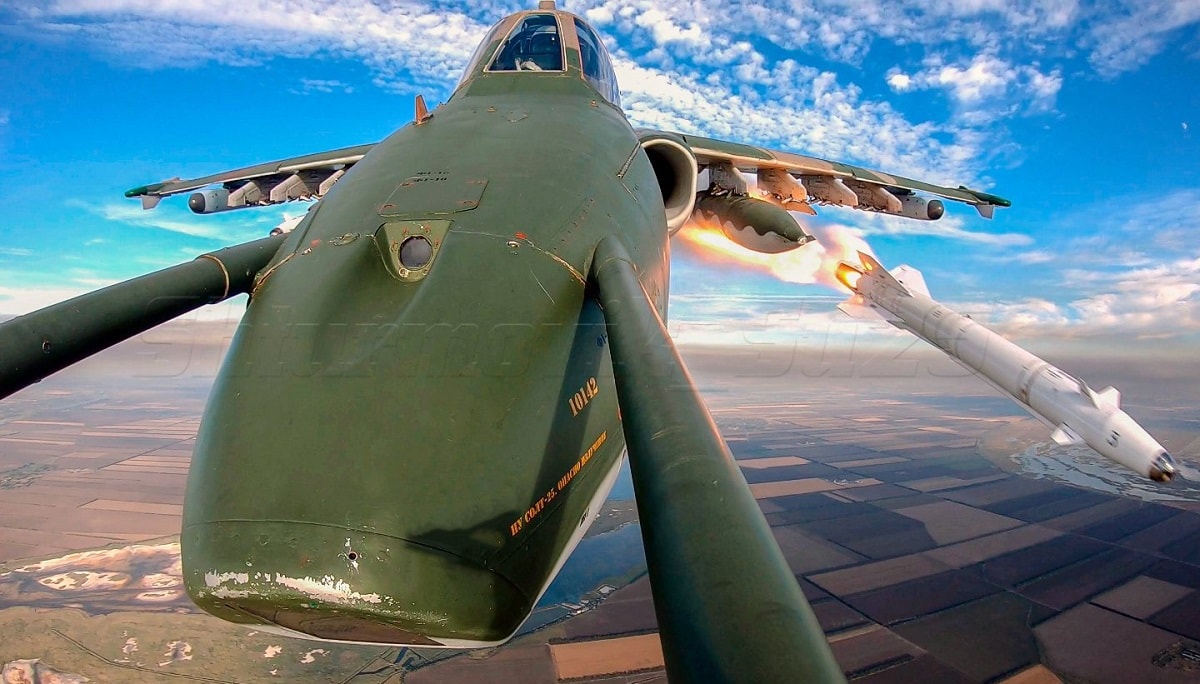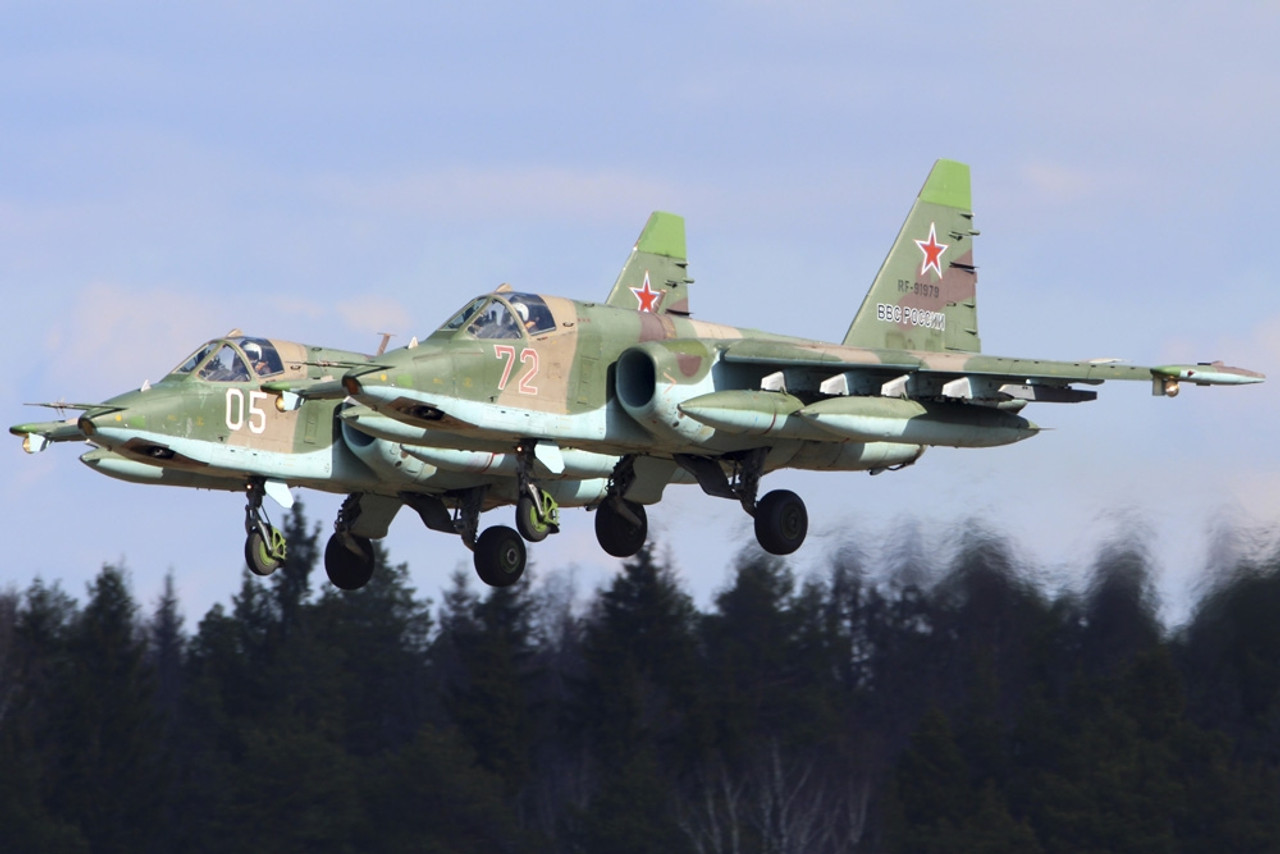Russia Su 25 - Sukhoi Su-25 Grach (Russian: Grach (ladya); NATO reporting name: Frogfoot) is a single-seat subsonic twin-engined jet aircraft developed in the Soviet Union by Sukhoi. It was designed to provide close air support for Soviet ground forces. The first prototype made its maiden flight on February 22, 1975. After testing, the aircraft was put into serial production in 1978 in Tbilisi in the Georgian SSR.
Early versions included the Su-25UB two-seat trainer, Su-25BM for target towing, and Su-25K for export customers. Some aircraft were upgraded to Su-25SM standard in 2012. The Su-25T and Su-25TM (aka Su-39) were further developments and were not produced in significant quantities. The Su-25 and Su-34 were the only armored aircraft produced in 2007.
Russia Su 25

Su-25s are in service with Russia, other CIS countries and export customers. Grandfather production Su-25 in 2017 in Russia
How Does The Russian Su 25 Compare To The A 10 Warthog?
Since its service more than 41 years ago, the Su-25 has seen action in several conflicts. This type actively participated in the Soviet-Afghan war, performing counterinsurgency tasks against the Afghan mujahideen. The Iraqi Air Force used it against Iran during the 1980-88 Iran-Iraq War. Most Iraqi examples were later destroyed or shipped to Iran during the 1991 Gulf War. The Georgian Air Force used the Su-25 during the Abkhazia War from 1992 to 1993. The Macedonian Air Force used the Su-25s against Albanian rebels in the 2001 Macedonian conflict, and in 2008 Georgia and Russia used Su-25s in the Russian-Macedonian conflict. Georgian War. African states, including Côte d'Ivoire, Chad and Sudan, have used the Su-25 in local rebellions and civil wars. At this time, Su-25s have taken part in the Russian intervention in the Syrian civil war, in fighting in the 2020 Nagorno-Karabakh War, and in the 2022 Russian invasion of Ukraine.
In early 1968, the USSR Ministry of Defense decided to develop a specialized armored attack aircraft for close air support of the Soviet ground forces. The idea to create a support aircraft arose after analyzing the experience of assault (assault) aviation in the 40s, 50s and 60s.
The Soviet fighter-bombers (Su-7, Su-17, MiG-21 and MiG-23) in service or under development at that time did not meet the requirements of direct air support for the army.
They lacked the armor necessary to protect the pilot and vital equipment from ground fire and missile impacts, and their high speed made it difficult for the pilot to maintain eye contact with the target. Given these problems, Pavel Sukhoi and a group of leading specialists from the Sukhoi Design Bureau in a relatively short time, with the assistance of leading institutions of Minaviaprom and the Ministry of Defense, began pre-design work. .
Sukhoi Su 25 Grach Frogfoot Single Seat, Twin Engine Jet Aircraft Editorial Image
In March 1969, the USSR Air Force announced a competition for the development of a new aircraft for close battlefield support. The participants in the competition were the Sukhoi Design Bureau and the Design Bureau of Yakovlev, Ilyushin and Mikoyan.
Sukhoi completed development of the T-8 in late 1968 and began work on the first two prototypes (T8-1 and T8-2) in January 1972. Assembly of the first T8-1 airframe was completed on 9 May 1974. An Another source indicates November 1974. However, it made its maiden flight only on February 22, 1975, after a long series of test flights by Vladimir Ilyushin. The Su-25 surpassed its main competitor in the Soviet Air Force competition, the Ilyushin Il-102, and the Ministry of Defense has announced mass production.
At the stage of flight tests of the T8-1 and T8-2 prototypes, the management of the Sukhoi Design Bureau proposed to start serial production of the Su-25 at plant No. 31 of Tbilisi, the Georgian SSR, which at that time was the main production base for the MiG-21UM Mongol B". After negotiations and completion of all stages of state tests, the Ministry of Aircraft Engineering of the USSR allowed production of Su-25 in Tbilisi, which allowed mass production to start in 1978.

In the late 1980s and early 1990s, several variants of the Su-25 appeared, including upgraded versions and variants for specialized missions. The most significant developments were the Su-25UB two-seat trainer, the Su-25BM target towing variant and the Su-25T for anti-tank missions. Also, the Su-25KM prototype was developed by Georgia in cooperation with the Israeli company Elbit Systems in 2001, but so far this variant has not achieved much commercial success. As of 2007
Russian Su 25 Crashes Amid Training, Pilot Dies
The Russian Air Force, which has the largest number of Su-25s in service, planned to upgrade older aircraft to the Su-25SM variant, but lack of funding has slowed this process; by early 2007, only seven aircraft had been modified.
The Su-25 has a conventional aerodynamic layout with a trapezoidal trapezoidal wing, traditional tail and rudder. The airframe design uses different metals: 60% aluminum, 19% steel, 13.5% titanium, 2% magnesium alloy and 5.5% other materials.
All modifications of the Su-25 have a medium-width cantilever metal wing with a large aspect ratio and are equipped with mechanized devices. The wing consists of two cantilevered sections fixed to the central box, forming a single body with the fuselage. The air brakes are housed in fairings at the ends of each wing. Each wing has five mounting points for weapon mounting and the mounting points are mounted to the ribs and spars of the mount.
The flaps are attached with sliders and steel rollers attached to brackets on the rear spar. Trapezoidal ailerons are located at the tips of the wings.
Wallpaper The Sky, Sky, Dry, Rook, Su 25, The Russian Air Force, Attack, Russian Air Force, Su 25 Images For Desktop, Section авиация
The fuselage of the Su-25 has an ellipsoidal section, semi-monocoque, reinforced skin, made in the form of a longitudinal bearing frame of spars, beams and stringers with a transverse bearing unit of frames.
Early versions of the Su-25 were equipped with two R-95Sh turbojet engines without afterburner in compartments on either side of the rear fuselage. The gins, groups, and surrounding fuselage are cooled by air entering through vents at the top of the nacelles of the nacelle. The drainage system collects oil, residual hydraulic fluid and fuel from the engines after flight or after a failed launch. Gin control systems ensure that each genie operates independently.
The autocannon is located in a compartment behind the cockpit, mounted on a load-bearing beam attached to the cockpit floor and forward fuselage support structure. The nose section features the characteristic double pitot calibres and service hinges.

The pilot controls the aircraft using the Ctre joystick and left throttle. The pilot sits in the Zvezda K-36 ejection seat (similar to the Su-27) and has standard flight instruments. At the rear of the cab is a six-millimeter (0.24 in) thick steel headrest mounted on the rear bulkhead. The cockpit has an armored closure in the shape of a welded titanium sheet tank with transit windows in the sides. Rails for the ejection seat are installed on the rear wall of the cabin.
Su 25 Vs A 10: Here's Why The Frogfoot Might Be Better Suited Than The Warthog For Cas
The canopy hinges turn to the right and the pilot uses a folding ladder. Once inside, the pilot sits low in a tub-protected cockpit, making the cockpit cramped. Visibility from the cockpit is limited, which is the trade-off for better rider protection. Rear visibility is poor, a periscope is installed at the top of the lantern to compensate.
A folding ladder integrated into the left fuselage provides access to both the cockpit and the aircraft roof.
The base model of the Su-25 includes a number of key avionics systems. It is not televised, but does include a distinctive nose-mounted laser rangefinder believed to provide laser-assisted target acquisition.
For navigation, the DISS-7 Doppler radar is used; The Su-25 can fly at night, under visual and instrument weather conditions.
No Rafale, Typhoon Or F 16, Why Is Eu Providing Obsolete Fighter Jets To Ukraine To Battle A Superior Russian Air Force?
Air-to-ground and air-to-air radio stations are often installed on the Su-25, including the SO-69 Identification Friend or Foe (IFF) transponder. The aircraft self-defense complex includes various means, such as flares and chaff spreaders capable of launching up to 250 flares and chaff. Protection against hostile use of radar is carried out using the SPO-15 radar warning receiver.
The new Su-25TM and Su-25SM models have an enhanced avionics and weapons system, which increases survivability and combat effectiveness.
The first Soviet Air Force Su-25 unit was the 80th Assault Aviation Regiment, formed in February 1981 at the Sitalchay Air Base in the Azerbaijan SSR.

On 19 July 1981, the 200th Independent Attack Squadron was transferred to Shindand Air Base in western Afghanistan, becoming the first Su-25 unit deployed to that country. Its primary mission was to carry out airstrikes against mountain military posts and installations controlled by Afghan rebels.
Us A 10 Warthog Vs Russian Su 25 Frogfoot: Who Is The Real \
Another Soviet Su-25 unit was the 368th Assault Aviation Regiment, formed on July 12, 1984 at Oktyabrsky in Ukraine.
During the Soviet-Afghan war, Su-25s fired 139 guided missiles of all types at mujahideen positions. On average, each aircraft flew 360 sorties a year, far more than any other combat aircraft in Afghanistan. By the end of the war, approximately 50 Su-25s were stationed at Afghan air bases, totaling 60,000 sorties. Between the first deployment in 1981 and the start of the war in 1989, 21-23 aircraft were lost in action,
Su 25, su-25 frogfoot, su 25 flanker, su 25 tm, trumpeter su 25, sukhoi su 25 frogfoot, su 25 model, su 25 model kit, su-25, 1 48 su 25, su 25 sm, su 25 1 144
0 Comments